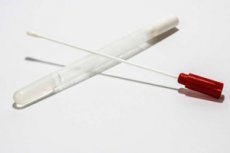New publications
Skin smears can detect Parkinson's disease 7 years before first signs
Last reviewed: 27.07.2025

All iLive content is medically reviewed or fact checked to ensure as much factual accuracy as possible.
We have strict sourcing guidelines and only link to reputable media sites, academic research institutions and, whenever possible, medically peer reviewed studies. Note that the numbers in parentheses ([1], [2], etc.) are clickable links to these studies.
If you feel that any of our content is inaccurate, out-of-date, or otherwise questionable, please select it and press Ctrl + Enter.

A new study has shown encouraging progress in developing a non-invasive method for diagnosing early signs of Parkinson's disease - up to seven years before motor symptoms appear - by analysing the chemical composition of the skin.
The findings, published today in the journal npj Parkinson's Disease, show that compounds or "volatiles" found in sebum - the oily substance produced by our skin - contain key biomarkers for detecting Parkinson's disease in its earliest stages.
Using a technique known as thermal desorption-gas chromatography-mass spectrometry (TD-GC-MS), scientists from the University of Manchester, Salford Royal NHS Trust and the University of Innsbruck analysed skin swabs taken from participants with Parkinson's disease, healthy volunteers and patients with a sleep disorder called isolated REM sleep behaviour disorder (iRBD) - a known early precursor to Parkinson's disease.
The results showed that people with iRBD had a chemical profile of sebum that was different from healthy people, but not as pronounced as those with established Parkinson's disease. This supports the idea that Parkinson's disease leaves a detectable mark on the body long before physical symptoms appear.
Joy Milne, the “super sniffer” whose abilities inspired the study, was also able to distinguish swabs from people with iRBD from controls and Parkinson’s patients. Remarkably, she identified both conditions in two people in the iRBD group who were actually diagnosed with Parkinson’s at a subsequent medical check-up after the samples were taken.
"This is the first study to demonstrate a molecular diagnostic method for detecting Parkinson's disease at a prodromal or early stage. It brings us closer to a future where a simple non-invasive skin swab could help identify people at risk before symptoms develop, allowing for earlier intervention and improved prognosis," said Perdita Barran, professor of mass spectrometry at the University of Manchester.
The study involved more than 80 people, including 46 patients with Parkinson's disease, 28 healthy volunteers, and nine people with iRBD. The researchers identified 55 significant features in sebum that differed between the groups. People with iRBD often had levels of these features that were between those of the healthy group and the group with Parkinson's disease, further supporting the possibility of detecting the disease at an early stage.
Dr Dhrupad Trivedi, a researcher at the University of Manchester, created a model that looked at markers in a longitudinal study where samples were collected from patients with Parkinson's disease over three years. He found patterns that suggested the method could also be used to track the progression of the disease, which could help refine treatment options and improve outcomes for patients.
Sebum is easily collected using gauze swabs from the face or upper back, making it ideal for non-invasive routine screening and regular monitoring. Previous research by the team has also shown that sebum does not require refrigeration like other biofluids, such as blood, reducing the associated costs.
The research was inspired by the observations of Joy Milne, who noticed a unique odour in people with Parkinson's disease, which prompted scientists at the University of Manchester to study sebum as a source of diagnostic biomarkers.
Using mass spectrometry - a technique that measures the mass of molecules - they found that sebum contained characteristic markers of Parkinson's disease, allowing them to develop this non-invasive test.
These findings were recently confirmed in another paper published today in the Journal of Parkinson's Disease, where trained dogs were able to accurately detect Parkinson's disease in patients by smelling skin swabs.
Researchers are now continuing to refine the sebum-based diagnostic method for further use in clinical practice.
“Our goal is to develop a reliable, non-invasive test that will help doctors detect Parkinson’s disease early, monitor its progression and ultimately improve outcomes for patients,” said Dr. Trivedi.
"We also want to reach out to other hyperosmic people - potential 'super-sniffers' like Joy, whose extraordinary sense of smell could help extend our work to detect other diseases with potential olfactory markers," he added.
